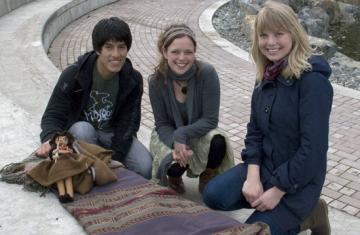Student’s work supports education, preserves tradition in the Andes
- Patty Pitts

Most people who visit Peru’s Sacred Valley near Cusco take the train to Machu Picchu, buy some whisper-soft alpaca scarves and marvel at the intricate weavings produced by the Indigenous Quechua people from the surrounding villages.
But UVic grad Ashley Akins’ 2006 visit turned into so much more. Since first visiting Peru’s high-altitude valley, she’s established Mosqoy, an organization to fund the post-secondary education of the villages’ young people, and the Q’ente Textile Revitalization Society to preserve and expand the Quechua weaving tradition. It, in turn, partially funds Mosqoy.
“It’s funny,” she said, back at UVic to complete a community research fellowship with the Centre for Co-operative and Community-Based Economy. “Four years ago I thought my life was full and complete. Now I couldn’t imagine it without Mosqoy.”
The Q’ente Society now involves 300 weavers from 35 communities who create intricate work on traditional back-strap looms using pure wool and natural dyes. Akins sells the weavings in Canada and divides the proceeds into quarters among the individual weavers, community initiatives of their choosing, Mosqoy and a reinvestment into the Q’ente Society.
In May Mosqoy will graduate its first 18 students and one of them, Rolando Auccapuri Iturriaga, is deferring the practicum placement all students must complete before receiving their diploma to spend a term at UVic studying English through UVic’s English Language Centre, which has waived his tuition. Akins hopes to raise enough funds to bring two top graduating Mosqoy students to UVic every year to improve their language skills and act as cultural exchange ambassadors on behalf of Mosqoy between Peru and Canada.
Iturriaga says he likes “everything” about his stay in Victoria, despite finding it difficult to find some of his favourite foods. “At home you don’t need to go to a store,” he explains. “You just pick fruit off a tree or go to a neighbour’s farm.”
Mosqoy has also spawned its own campus club which raises $10,000 each year through various events under the guidance of club director Jasmine Nielsen. “Mosqoy is a very dynamic organization, and it provides the opportunity to critically reflect on what we’re doing,” says the environmental and women’s studies major. “It’s more of a partnership than a ‘top down’ organization, which is what often happens in the NGO world.”
Although Mosqoy is just four years old, Akins is already anticipating its future. One of the organization’s first two co-op students, Beatriz Palacios Fernandez, is working to make Mosqoy “sustainable in the long term” by developing a strategy and governance structure that will guide it through the next five to 10 years. Akins’ concern for the sustainability of Sacred Valley’s population and its weaving culture extends to Mosqoy itself, and this will probably be the focus of her graduate studies, as she pursues her master’s in international human rights law at Oxford University. She’s hoping to determine whether the Mosqoy/Q’ente model can be adapted to serve other communities where poverty limits the ability of young people to pursue the education required for better employment and where a traditional culture is under threat from a tourist market demanding cheaper, less authentic products.
But first, she has a graduation ceremony to attend in Peru.

